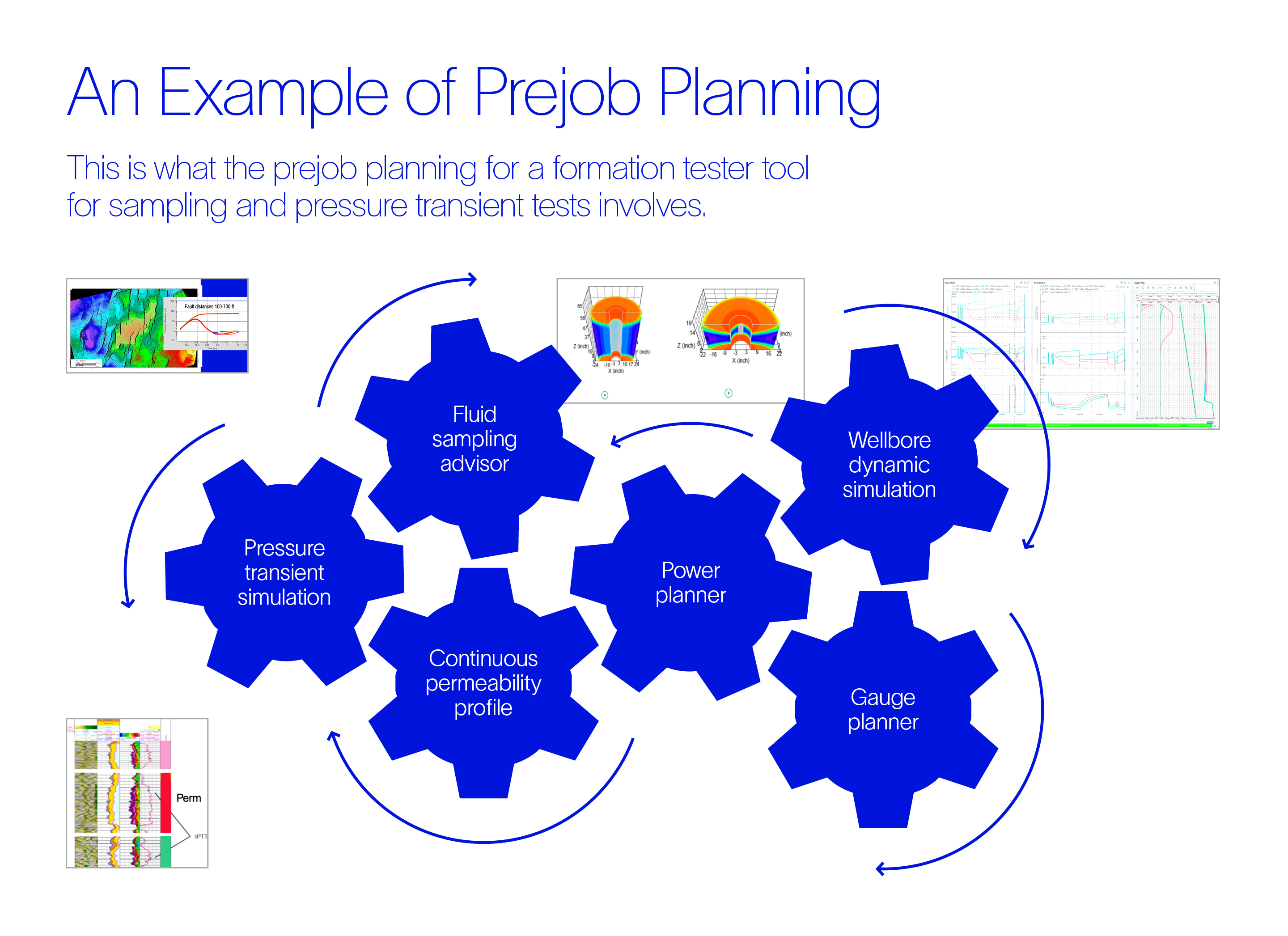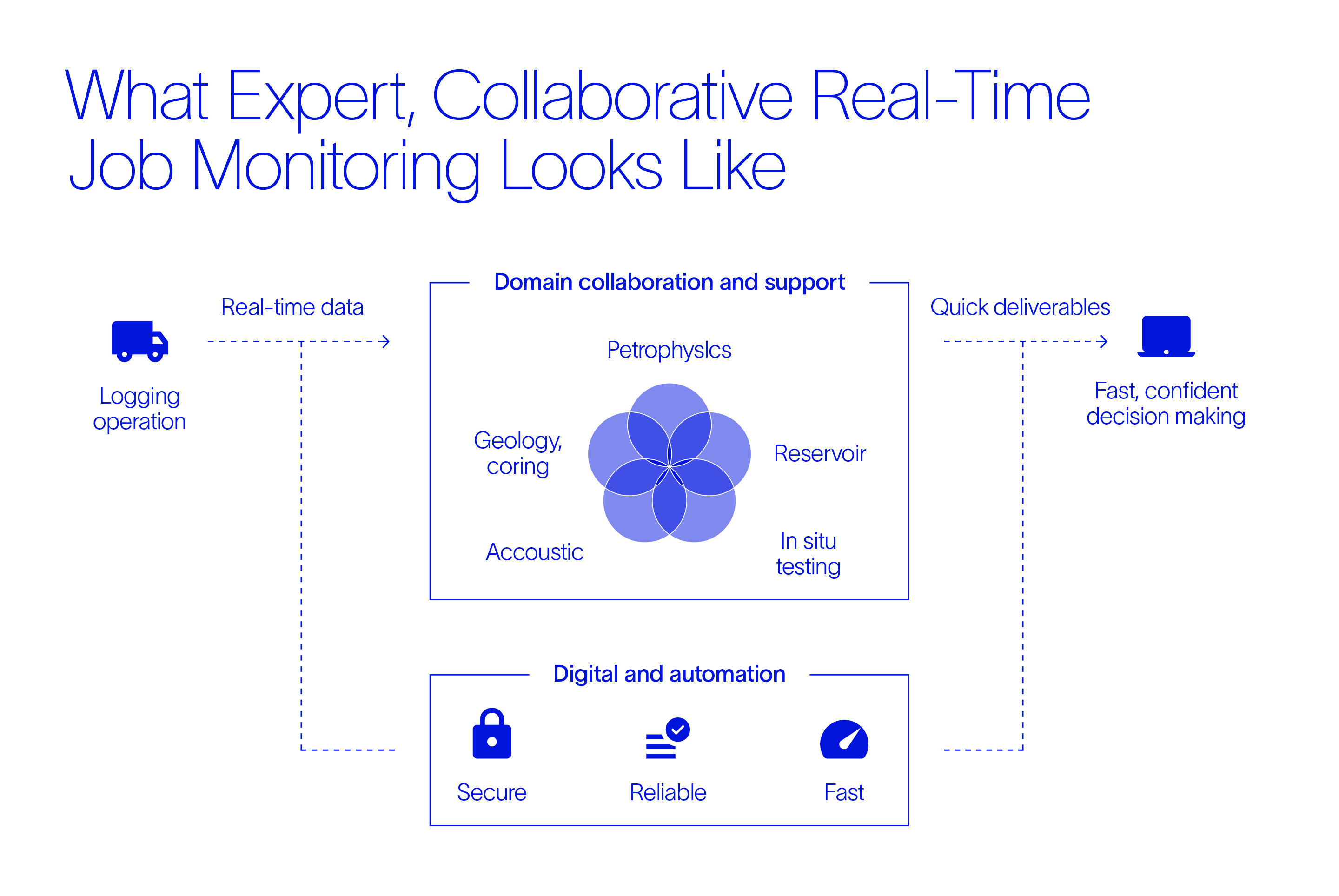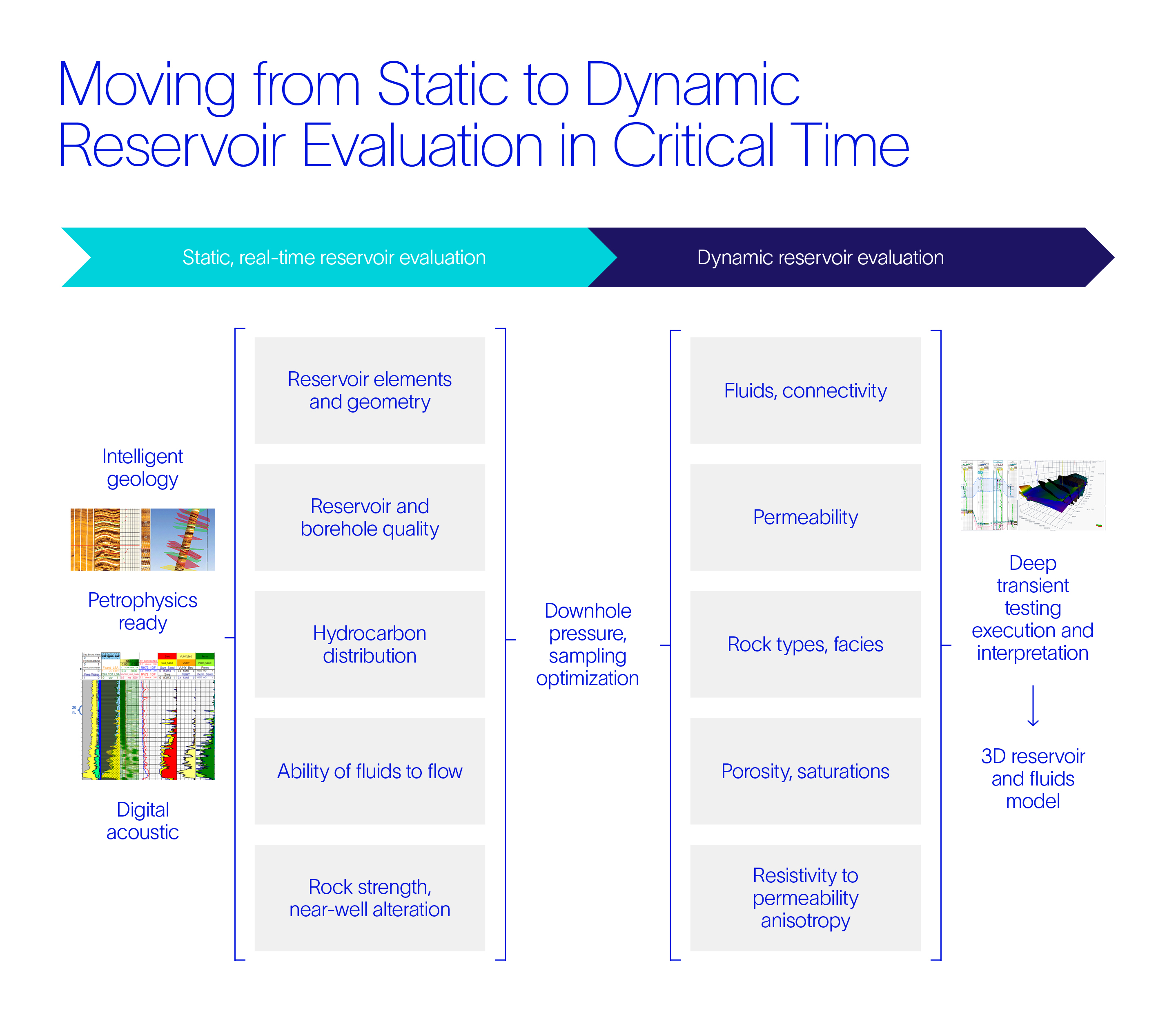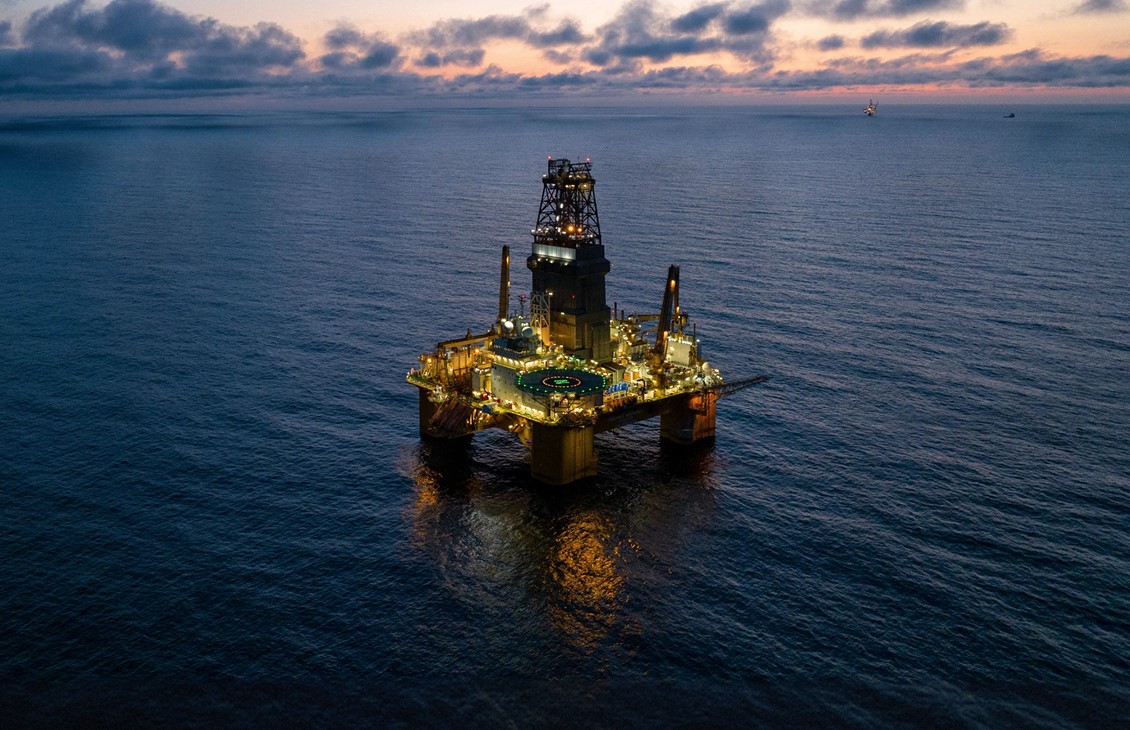Accurate formation evaluation and the ability to provide near real-time insights from in situ measurements are crucial to unlocking the potential of new reserves or repurposing existing assets. They’re what enable you to make informed decisions within critical operational time frames.
Well logging tech has rapidly evolved in the last decade. Traditionally, logging and log data analysis were performed at different times, but recent industry advancements have revolutionized the process. Technical experts can now connect, design, and run optimal logging evaluation programs for quicker and more confident field development strategies.
Thanks to enhanced telemetry, edge and cloud processing, deep domain knowledge, and the latest hardware, log data has been accessible in real time for the last several years. Data processing can be performed earlier and more efficiently, even while wireline tools are still downhole. The shorter time frame means more rapid progression through the usual process:
- collecting all the data necessary for addressing reservoir challenges
- validating and integrating the data in real time
- updating the acquisition plan or optimizing time and subsequent logging runs
- effectively preparing for the next step.
And let’s not forget the contribution that reducing logging time, data processing, and data interpretation makes toward achieving our industry’s larger goals. It aligns well with the need for all subsurface evaluation programs and solutions to reduce emissions through the strategic use of innovative tech, expertise, and enhanced efficiency.
Architecting a digital space in which state-of-the-art logging tools, artificial intelligence, and interpretation techniques can collaborate effectively addresses most evaluation challenges more effectively and efficiently. Logging acquisition programs are designed to do just that. They enable critical decisions to be made instantly by ensuring data is available for not only immediate but also long-term application.
Prejob planning is the key to enhanced reservoir evaluation
Effective planning for well formation evaluation begins with the early selection of logging services, mode of deployment, and operational techniques. For this to happen while simultaneously recording high-quality data, a thorough understanding of the logging objectives and expected evaluation challenges is essential. Such understanding also allows the job to be designed with safety as the main priority.
It’s deep domain knowledge that helps address this need by answering several questions:
- What is the reservoir type, along with the expected range of porosity and permeability?
- Which reservoir fluids are expected, and are there any contaminants such as carbon dioxide, hydrogen sulfide, or mercury?
- What are the well profile, downhole temperature, and pressure prognosis?
- What is the drilling mud type, and is any operational risk expected?
The time of easy oil has passed. Today, many of the reservoirs are deeper, hotter, and more challenging to reach with conventional methods. They may have lower rock quality and less predictable potential. The target formations often consist of stacked reservoirs and heterogeneous layers with mixed lithology and highly variable rock properties.
This complexity generally translates to a similarly complex fluid distribution. Challenges may include vertical and lateral reservoir discontinuity, formation anisotropy, fresh and variable formation water salinity, presence of near-critical and near-saturated fluids, waxy oil, heavy oil, and condensates. These factors must be considered for comprehensive net pay characterization, producibility, and flow assurance assessments.
To select the best logging techniques for accurately evaluating the expected reservoirs, job planners (combined with detailed experience and technical knowledge) are used to perform prejob simulations and log response predictions for every logging tool. This process simultaneously helps identify the right tool combination for efficiently and effectively performing the logging execution without compromising data quality.

Real-time job monitoring now integrates domain knowledge
Data acquisition increases in value when it can be used to quantify and prove reserves while enabling fast decision making within an important time window. A comprehensive logging program is successful when it provides requested information and answers promptly, thereby maximizing the use of data acquired during logging measurement.
Nowadays, logging data can be simultaneously viewed and analyzed in real time by multiple users from anywhere. Technical experts can meet online in collaborative, digital spaces to exchange information, perform quality control, and facilitate accurate data acquisition by optimizing the logging program along the way. They are, in turn, empowered by the improved capabilities of acquisition and interpretation software—now powered by advancements like automation—that accelerate data integration, processing, and interpretation.

Standard data analysis workflows traditionally require considerable domain expertise and time (i.e., weeks or months). Today, however, complete reservoir characterization and advanced 3D reservoir modeling (the kind that combines high-resolution petrophysical and geological logs with dynamic data) can be performed within days. This accelerated process can successfully evaluate reservoir heterogeneity and deliverability, fast-tracking development without the intervention of too many technical experts.
Digital workflows that interpret and characterize well data in real time
Effectively combining fit-for-purpose petrophysical logging technologies enables the real-time characterization of porosity, permeability, and hydrocarbon potential. This is a direct input for the downhole formation testing workflow and optimizes the acquisition of formation pressure, sampling, and pressure transient data.
Meanwhile, specialized algorithms can classify the rock into distinct quality facies, categorize the interval for assessment based on geological and reservoir attributes, and help validate ad hoc producibility cutoffs. These algorithms also compute continuous permeability profiles to effectively calibrate the flowing data from formation testers. In many cases, fit-for-basin approaches and interpretation methods—such as advanced thin bedded analysis in the case of otherwise-overlooked laminated sequences—reveal additional footage of pay and hydrocarbon volumes. These findings can be validated quickly by downhole testing and fluid samples analysis, ultimately increasing prospective value and securing the reserves booking, all while managing the associated risks.
High-definition wellbore imaging, dip interpretation, and structural modeling—which would typically take days to process manually in such complex settings—can now be completed within hours using digital and machine learning techniques. Innovative workflows that integrate image logs with petrophysics, acoustics, and rock mechanics are just one click away. These workflows improve the calculation of zonal flow contribution to select the optimal intervals for extended downhole testing analysis while simultaneously contributing to the definition of the 3D numerical models.
In parallel, a digital acoustic platform enables real-time visualization of formation anisotropy and its types, which could have significant implications on completion decisions and help derisk future well trajectories through comprehensive stress characterization.
The real-time integration of petrophysics, sonic, image, and caliper logs is also used to define and prioritize the program for collecting large-size sidewall core plugs. This approach also enhances success rates based on rock parameters, type analysis, and automated strength calculation from previous logging runs.
Furthermore, existing reservoir models can be calibrated in near real time to deliver detailed contextual value, with simulations from log to reservoir scale conducted using in situ log measurements. This systematic workflow helps enhance a standard one in which reservoir types and behavior are assumed using analytical models that match pressure transient data.
Such simulations encourage the incorporation of more complex reservoir geometries, behaviors, and heterogeneities into the reservoir model—which, in turn, helps match it straight away with dynamic testing data. This link between the static and dynamic information and upscaling is immediately leveraged to quantify the reserve’s drainage radius, minimum connected hydrocarbon volumes, and reservoir boundaries. The 3D model can also be used for the completion design, production strategy, and other aspects of future field developments.

Making the right decisions in operational time
The benefits of fit-for-purpose and cost-effective solutions for successful appraisals are maximized when combined with real-time acquisition and interpretation of data performed in a collaborative environment. Petrotechnical experts, with the assistance of digital workflows and automation, not only ensure high-quality data acquisition, but also quickly evaluate that data for further decisions, thereby saving everyone significant rig time spent on expensive operations.
When assessing reservoir potential today, actionable insights can be delivered within hours (while the logging program is still in progress), and critical decisions can be made within days rather than the weeks typically required. This approach ensures consistent interpretation with accurate results shared exactly when required and an impressively quick turnaround.
The best part about having faster and better-informed answers? Critical business decisions on issues such as drilling a sidetrack, running well testing, and completions planning—or simply optimizing downhole formation pressure, fluid sampling stations, or coring programs—can be taken confidently and on time.





